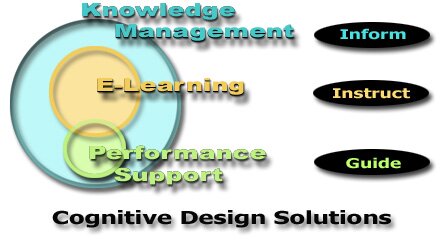|
 Training & Consulting > Mission & Vision Training & Consulting > Mission & Vision
Mission
The mission of Cognitive Design Solutions is to:
Promote effective individual and team learning
through the integrated use of Knowledge Management, E-learning and Performance Support solutions.
The goal is to improve individual, team and enterprise performance.
This is achieved by creating communication systems
that enable effective collaboration, and knowledge transfer systems that enable effective learning.

How:
- Provide consulting services in organizational development
- Apply the principles of cognitive science to learning technology solutions that: Inform, Instruct and Guide
- Design learner-centered environments for skill development and transfer of best-practices across the enterprise
- Deliver cost-effective, measurable results aligned to current business objectives and strategy
Why:
- Performance solutions require information at the right place, at the right time. Knowledge-sharing communities depend upon collaboration at every level of the enterprise. The optimum organizational environment supports communication, information access, and encourages this knowledge-sharing collaboration.
- Performance solutions are served by knowledge and skill training that can be delivered anywhere, anytime — overcoming place and time barriers. The optimum organizational envrionment provides on-demand access to learning resources.
- Individuals and teams develop new competencies by learning and practicing new knowledge, skills and attitudes in ways that allow integration through personal experience. To achieve this end, the optimum organizational environment is reinforcing, and supports risk taking, including the value of learning from mistakes.
- Empowered individuals and teams achieve new levels of enterprise productivity, creativity and innovation. The optimum organizational environment seeks to achieve these goals by direct performance support in the work environment.

Vision: An Integrated Approach to Organizational Development and Performance Improvement
The vision of Cognitive Design Solutions is to develop the optimum, most cost-effective way in which Knowledge Management, E-Learning and Performance Support can work together — in a particular setting — to orchestrate the delivery of an effective enterprise performance solution.

The design of three distinct environments that enable three kinds of performance strategies to be constructed: Inform, Instruct, and Guide.
In each environment these strategies utilize knowledge-sharing communities and collaborative tools, so the three environments are, in fact, inter-locking elements of a whole solution.

Knowledge Management (KM) strategy: Environmental design of KM is composed of some of the follow key structures — IT infrastructure, enterprise information flow, content archiving, document management and collaborative communication tools. KM design centers around information access, delivery and flow. In this way, KM can be seen as both a foundation and a context for performance solutions in the Cognitive Design model because both E-Learning and Performance Support depend upon this infrastructure.
- The powerful collaborative, networked environment established by a Knowledge Management strategy supports vital elements of E-Learning and Performance Support delivery processes. This is why the boundaries between these elements have often blurred.
- Peer-to-Peer, Manager-to-Team, and Instructor-to-Learner workflows can be re-defined (sometimes totally transformed) by the empowerment offered through information access and the collaborative tools provided by the KM environment. KM is, thus, a powerful instrument of organizational development and alignment.
Performance Support (PS) strategy: Environmental design of PS seeks to achieve the critical phase of transfer-of-learning. That is, to apply a new skill or knowledge in the natural task environment. Without transfer-of-learning no ultimate benefit (certainly no ROI) can be ascribed to training. Therefore, PS is the most important, but typically the most neglected aspect of the Cognitive Design model.
- Performance Support elements are best introduced initially within the controlled E-Learning environment, so that they are familiar resources when the learner is engaged in the distractions and stress of daily performance tasks.
- Ultimately, the learning process must take place in a real-world task environment — not just in the protected, controlled space of a physical or virtual training environment. For this reason, "training" (set apart from the task setting) is not always the needed answer to a performance problem.
- Knowledge Management and Performance Support (tools and methods) address issues such as: information access and flow, usability, helpdesk resources, logistics, goal setting and feedback, motivation and communication. These issues may be far more critical to a particular performance problem than resolving an actual knowledge or skill deficit. Often the performance need is for timely, accurate information/feedback delivered by the right person, to the right person, at the right time.
E-Learning strategy: using a blend of various instructional strategies (synchronous / asynchronous) — emphasizes collaboration, self-direction, multimedia, simulation, interactive engagement, practice and feedback, as well as traditional instructor-led classroom experiences. Blended E-Learning provides an "engine" driving organizational learning and development toward individual and team learning objectives & competencies (knowledge/ skills /attitudes). It is, therefore, the centerpiece of the Cognitive Design model.

|
|
 |
Mission &
Vision |
 |
|
|



